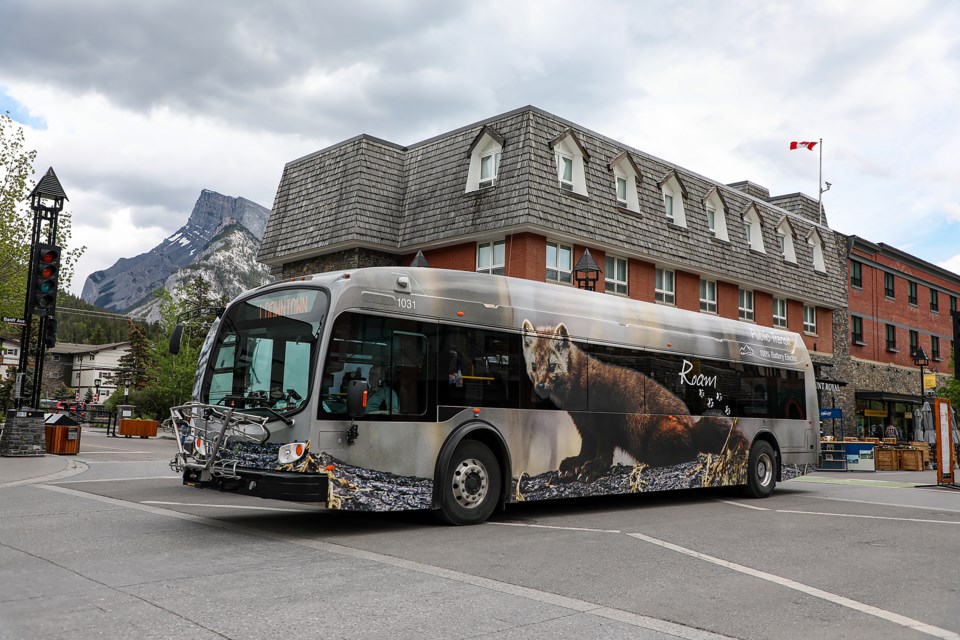BANFF NATIONAL PARK – A seasonal Roam transit route in Banff National Park will continue to run as part of a pilot project to a popular Parks Canada destination.
Parks Canada and Roam transit will continue to run the Johnston Canyon (Route 9) on weekends throughout the winter months. The route previously ran from late spring to Thanksgiving Day weekend, but the decision was made to keep the run active.
Daniella Rubeling, the visitor experience manager for the Banff field unit, said a goal in the Banff National Park management plan is to move people more sustainably, invest in public transit to help limit traffic, promote mode shift transit and reduce greenhouse gases.
“We’ve looked at the visitation to that trail in the winter. It's a very popular destination, it's a beautiful place in the winter, and I've taken my family there too. It's a really lovely walk to be able to do and so this is offering people another alternative way to get there and a way to leave their car at home or at the hotel and be able to take transit out there,” she said.
“It's part of our larger look at how we use transit, not just in the summertime.”
The Banff National Park management plan, which was was released this summer, emphasizes the need for public transit to help move people from one destination to another to limit congestion and greenhouse gases.
Martin Bean, the CAO for Roam, said the pilot is another way to help get people to Johnston Canyon, one of the more popular tourism areas in the national park.
“It’s meant to enable people to get out and enjoy the Johnston Canyon area without having to drive out there and not have to worry about parking.”
The weekend run will have one bus and five departures going back and forth from Banff Community High School to Johnston Canyon. The first bus leaves Banff at 8:30 a.m. and the last bus from Johnston Canyon departs at 4:55 p.m.
A single fare for people 19 to 64 is $5, while seniors and youth are $2.50. A one day pass for 19 to 64 is $10, with seniors and youth paying $5.
Johnston Canyon is off the Bow Valley Parkway and roughly 25 minutes west of Banff. The site has the lower and upper falls as well as the Ink Pots. It’s a short distance from other nearby hiking trails such as Castle Mountain lookout and Moose Meadows.
This fall, Parks Canada began work to replace the pedestrian railing at Johnston Canyon between the lower and upper falls. It’s designed to improve visitor safety and keep people away from endangered birds that live and nest in the area.
“It’s progressing well. There will be some additional work happening throughout the winter. … It’s to improve both the safety as well as the visitor use management on that upper section of the trail,” Rubeling said.
“It will certainly help a lot of visitors feel a little bit more safe on that upper stretch of the trail.”
Several hundred thousand people visit Johnston Canyon each year, and while there’s nearby free and paid parking, the aim is to avoid parking congestion. Rubeling said there are between 3,000 to 4,000 visitors a day on busy weekends.
According to ridership numbers through the end of September, the Johnston Canyon route had 21,052 riders in 2022 compared to 10,993 in 2019. September saw 3,192 people take the route, a significant increase of 1,659 to September 2019.
The goal this past summer was to have the route run daily, but the bus driver shortage meant it ran only Fridays to Sundays.
Bean said the goal is to have the route run daily in the summer once again, but still offer weekend service in the late fall, winter and early spring.
“[Parks Canada] looked at various routes they could expand to year-round and that was one where the need was there in terms of parking and it’s a scenic route at all times of year,” he said.
Bean added Roam will continue to monitor ridership, but the public transit service has continued to see increased demand compared to its pre-COVID-19 pandemic ridership levels.
“The demand is there. Transit agencies are largely back up to 70 per cent pre-pandemic levels and we’re hitting more than 100 per cent on most routes.”
Rubeling said Roam and Parks Canada will pay close attention to the route usage and adapt to any changes as they learn whether the pilot continues or if an investment in the route is increased.
“It was one of the ones we wanted to trial and see how that goes. We'll see what the ridership looks like, and as with a lot of our places weather is a factor too,” she said. “We recognize that, but want to make sure that we take a look and see what that means for the future and how that fits within the long-term plan for Banff National Park, but also with the [Bow Valley Regional Transit Services] Commission strategic plan.”




